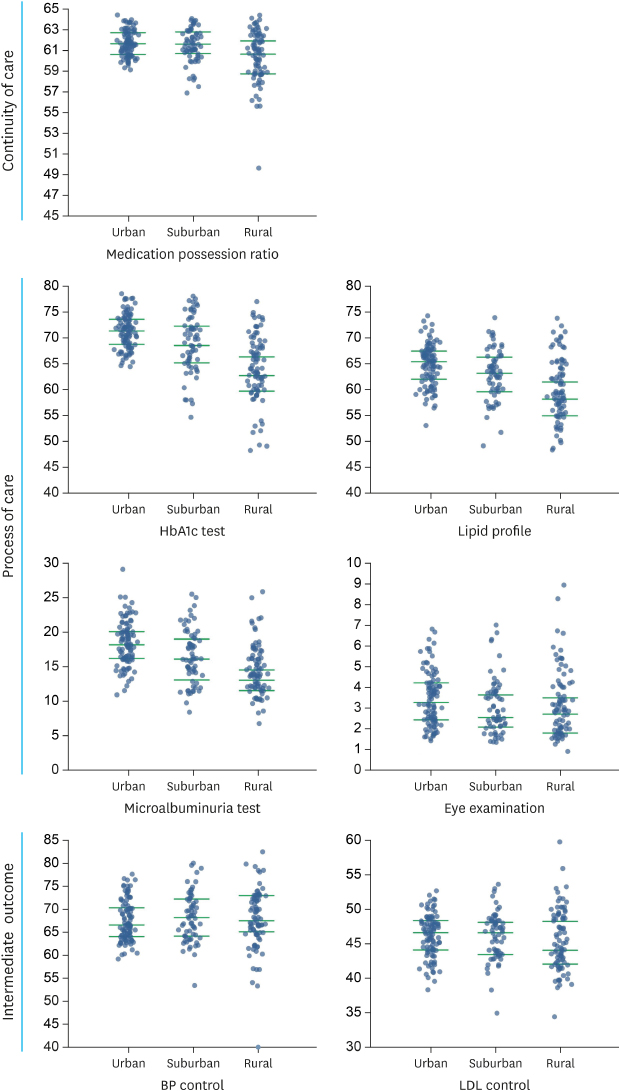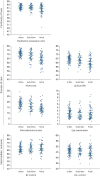1. Corallo AN, Croxford R, Goodman DC, Bryan EL, Srivastava D, Stukel TA. A systematic review of medical practice variation in OECD countries. Health Policy. 2014; 114(1):5–14.

2. Wennberg JE. Tracking Medicine. New York, NY: Oxford University Press;2010.
3. Organisation for Economic Co-operation and Development. Geographic Variations in Health Care: What Do We Know and What Can Be Done to Improve Health System Performance? Paris: Organisation for Economic Co-operation and Development publishing;2014.
4. Wennberg JE. Unwarranted variations in healthcare delivery: implications for academic medical centres. BMJ. 2002; 325(7370):961–964.

5. Marathe PH, Gao HX, Close KL. American Diabetes Association Standards of Medical Care in Diabetes 2017. J Diabetes. 2017; 9(4):320–324.

6. James SL, Abate D, Abate KH, Abay SM, Abbafati C, Abbasi N, et al. Global, regional, and national incidence, prevalence, and years lived with disability for 354 diseases and injuries for 195 countries and territories, 1990–2017: a systematic analysis for the Global Burden of Disease Study 2017. Lancet. 2018; 392(10159):1789–1858.
7. Yoon KH, Lee JH, Kim JW, Cho JH, Choi YH, Ko SH, et al. Epidemic obesity and type 2 diabetes in Asia. Lancet. 2006; 368(9548):1681–1688.

8. Chan JC, Malik V, Jia W, Kadowaki T, Yajnik CS, Yoon KH, et al. Diabetes in Asia: epidemiology, risk factors, and pathophysiology. JAMA. 2009; 301(20):2129–2140.
9. Park Y, Lee H, Koh CS, Min H, Yoo K, Kim Y, et al. Prevalence of diabetes and IGT in Yonchon County, South Korea. Diabetes Care. 1995; 18(4):545–548.

10. Korean Diabetes Association. Diabetes Fact Sheet in Korea 2018. Seoul: Korean Diabetes Association;2018.
11. Yoon J, Seo H, Oh IH, Yoon SJ. The non-communicable disease burden in Korea: findings from the 2012 Korean Burden of Disease Study. J Korean Med Sci. 2016; 31:Suppl 2. S158–S167.

12. Korean Diabetes Association. Treatment Guideline for Diabetes. Seoul: Korean Diabetes Association;2015.
13. Ko SH, Han K, Lee YH, Noh J, Park CY, Kim DJ, et al. Past and current status of adult type 2 diabetes mellitus management in Korea: a national health insurance service database analysis. Diabetes Metab J. 2018; 42(2):93–100.

14. Ko KD, Kim BH, Park SM, Oh SI, Um CS, Shin DW, et al. What are patient factors associated with the quality of diabetes care?: results from the Korean National Health and Nutrition Examination Survey. BMC Public Health. 2012; 12(1):689.

15. Song SJ, Han K, Choi KS, Ko SH, Rhee EJ, Park CY, et al. Trends in diabetic retinopathy and related medical practices among type 2 diabetes patients: Results from the National Insurance Service Survey 2006-2013. J Diabetes Investig. 2018; 9(1):173–178.

16. Kim SA, Park WS, Ohrr HC, Kang HY, Lee DH, Yi SW, et al. Prevalence and management status of diabetes mellitus in Korea. Korean J Med. 2005; 68(1):10–17.
17. Ji EJ. Factors associated with hemoglobin A1c among patient aged 40 years over with diabetes mellitus: 2012 Korea Health and Nutrition Examination Survey. J Korean Acad Fundam Nurs. 2015; 22(4):433–441.

18. Pyo EY, Jung MH, Kim YS. Factors Related to Blood Glucose Control in Patients with Diabetes. Korean J Health Educ Promot. 2012; 29(3):15–22.
19. Boo S. Glucose, blood pressure, and lipid control in Korean adults with diagnosed diabetes. Korean J Adult Nurs. 2012; 24(4):406–416.

20. Kim YM, Cho DG, Kang SH. An empirical analysis on geographic variations in the prevalence of diabetes. Health Soc Welf Rev. 2014; 34(3):82–105.
21. Arday DR, Fleming BB, Keller DK, Pendergrass PW, Vaughn RJ, Turpin JM, et al. Variation in diabetes care among states: do patient characteristics matter? Diabetes Care. 2002; 25(12):2230–2237.

22. Krein SL, Hofer TP, Kerr EA, Hayward RA. Whom should we profile? Examining diabetes care practice variation among primary care providers, provider groups, and health care facilities. Health Serv Res. 2002; 37(5):1159–1180.

23. Cook CB, Elias B, Kongable GL, Potter DJ, Shepherd KM, McMahon D. Diabetes and hyperglycemia quality improvement efforts in hospitals in the United States: current status, practice variation, and barriers to implementation. Endocr Pract. 2010; 16(2):219–230.

24. Cheol Seong S, Kim YY, Khang YH, Heon Park J, Kang HJ, Lee H, et al. Data resource profile: the national health information database of the National Health Insurance Service in South Korea. Int J Epidemiol. 2017; 46(3):799–800.

25. Johnson A, Stukel TA. Medical Practice Variations. 1st ed. New York, NY: Springer;2016.
26. Health Insurance Review and Assessment Service. Reimbursement Standards and Case Book for Hypertension and Diabetes. Wonju: Health Insurance Review and Assessment Service;2013.
27. Korea National Diabetes Program. Clinical Practice Guideline for the Prevention and Management of Diabetes in Korea. Seoul: Korea National Diabetes Program;2015.
28. Committee for Guideline for Management of Dyslipidemia. 2015 Korean guidelines for management of dyslipidemia. J Lipid Atheroscler. 2015; 4(1):61–92.
29. Kim Y, Lee TS, Park SK, Lee HY, Lee JY, Shin JY, et al. National Health Insurance Service Atlas Project 2016 Final Report. Wonju: National Health Insurance Service;2016.
30. Si D, Bailie R, Wang Z, Weeramanthri T. Comparison of diabetes management in five countries for general and indigenous populations: an internet-based review. BMC Health Serv Res. 2010; 10(1):169.

31. Gong YH, Yoon SJ, Seo H, Kim D. Associations between the continuity of ambulatory care of adult diabetes patients in Korea and the incidence of macrovascular complications. J Prev Med Public Health. 2015; 48(4):188–194.

32. Kim J, Kim H, Kim H, Min KW, Park SW, Park IB, et al. Current status of the continuity of ambulatory diabetes care and its impact on health outcomes and medical cost in Korea using national health insurance database. J Korean Diabetes Assoc. 2006; 30(5):377–387.

33. Kirkbride K, Wallace N. Rural health clinics and diabetes-related primary care for Medicaid beneficiaries in Oregon. J Rural Health. 2009; 25(3):247–252.

34. Strauss K, MacLean C, Troy A, Littenberg B. Driving distance as a barrier to glycemic control in diabetes. J Gen Intern Med. 2006; 21(4):378–380.

35. Andrus MR, Kelley KW, Murphey LM, Herndon KC. A comparison of diabetes care in rural and urban medical clinics in Alabama. J Community Health. 2004; 29(1):29–44.

36. Asghari S, Courteau J, Drouin C, Orzanco M, Vanasse A. Do geographical disparities affect the pattern of medication use in diabetic patients? Can J Diabetes. 2009; 33(3):228.

37. Tricco AC, Ivers NM, Grimshaw JM, Moher D, Turner L, Galipeau J, et al. Effectiveness of quality improvement strategies on the management of diabetes: a systematic review and meta-analysis. Lancet. 2012; 379(9833):2252–2261.








 PDF
PDF Citation
Citation Print
Print





 XML Download
XML Download